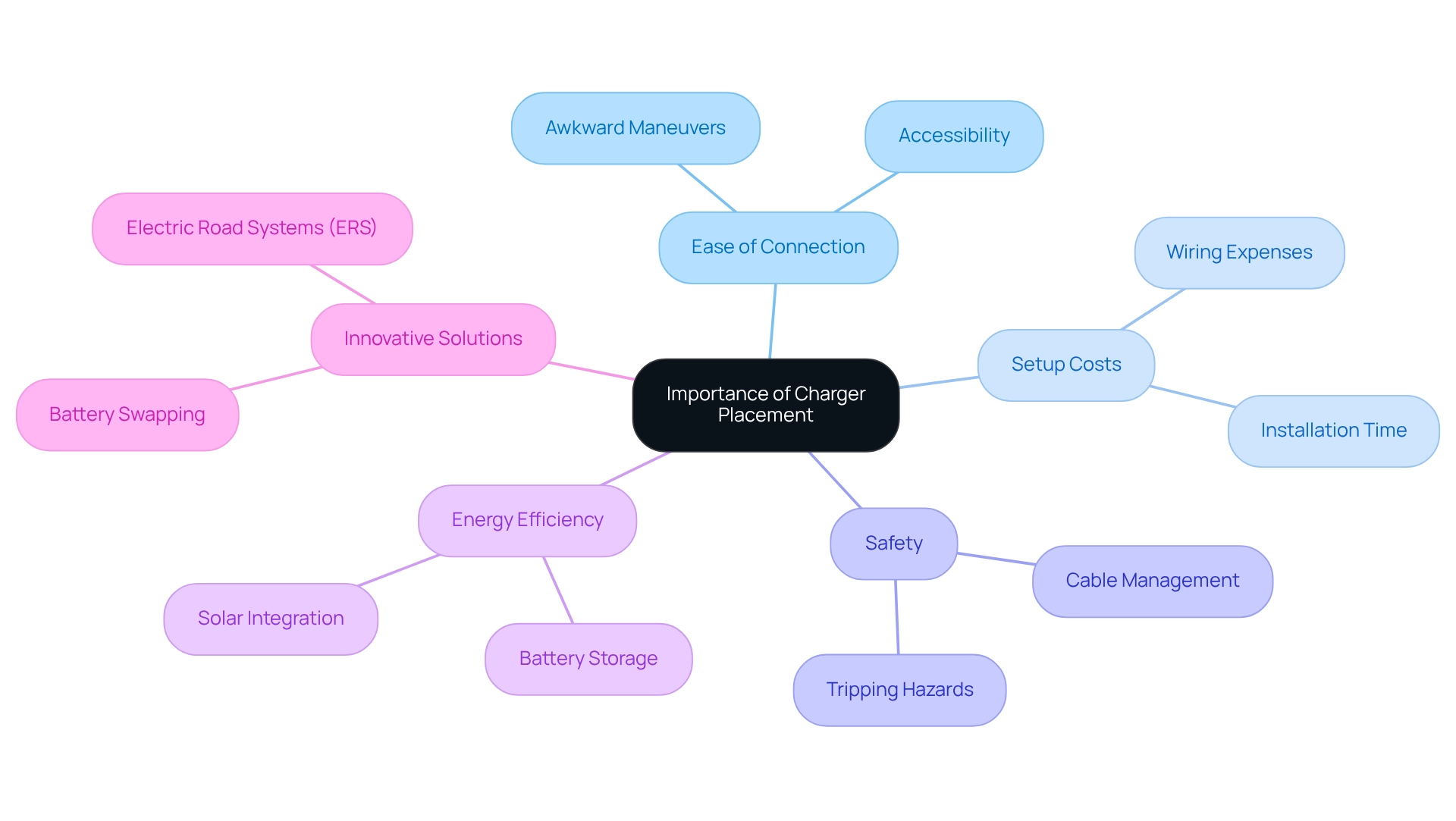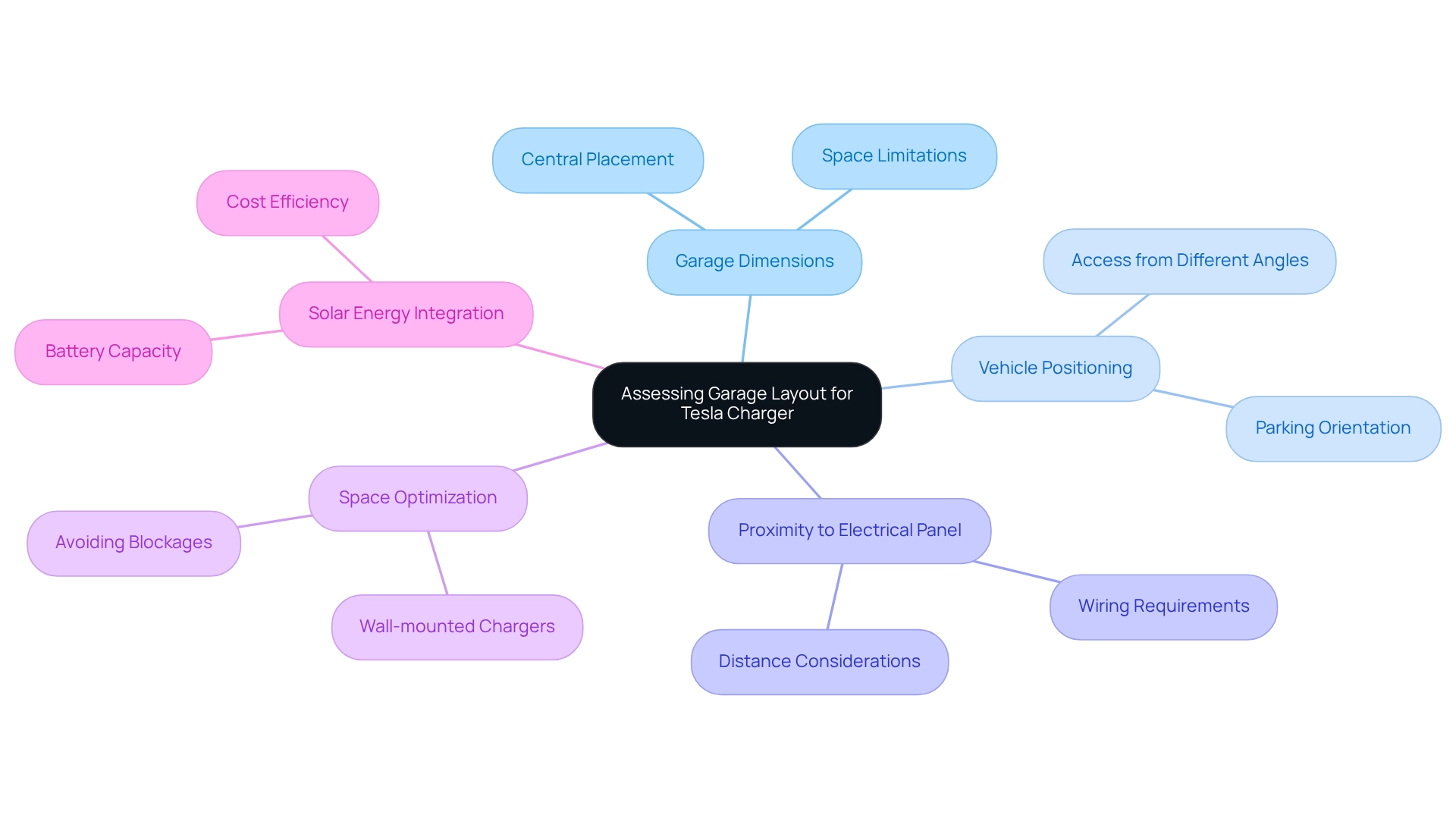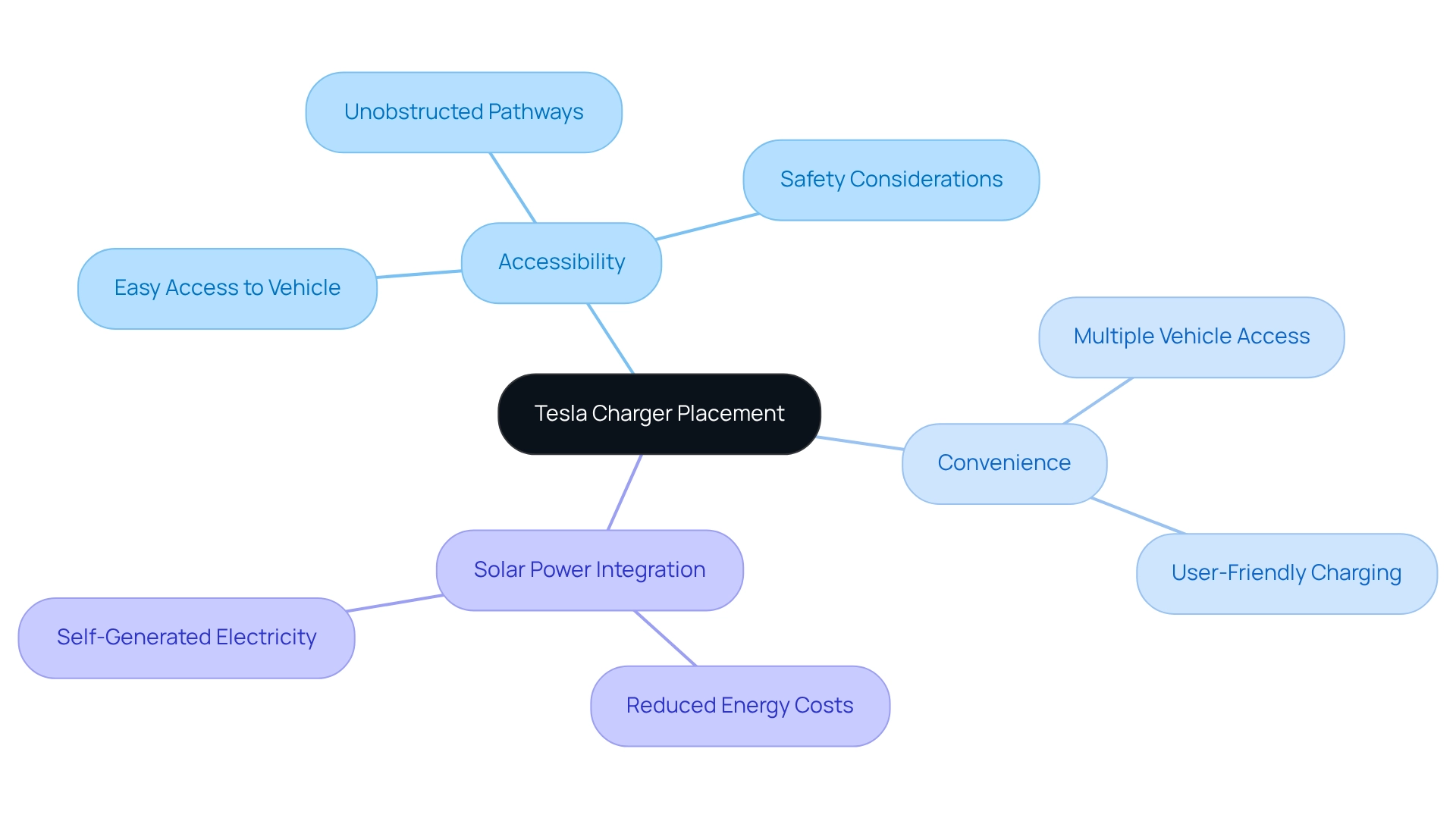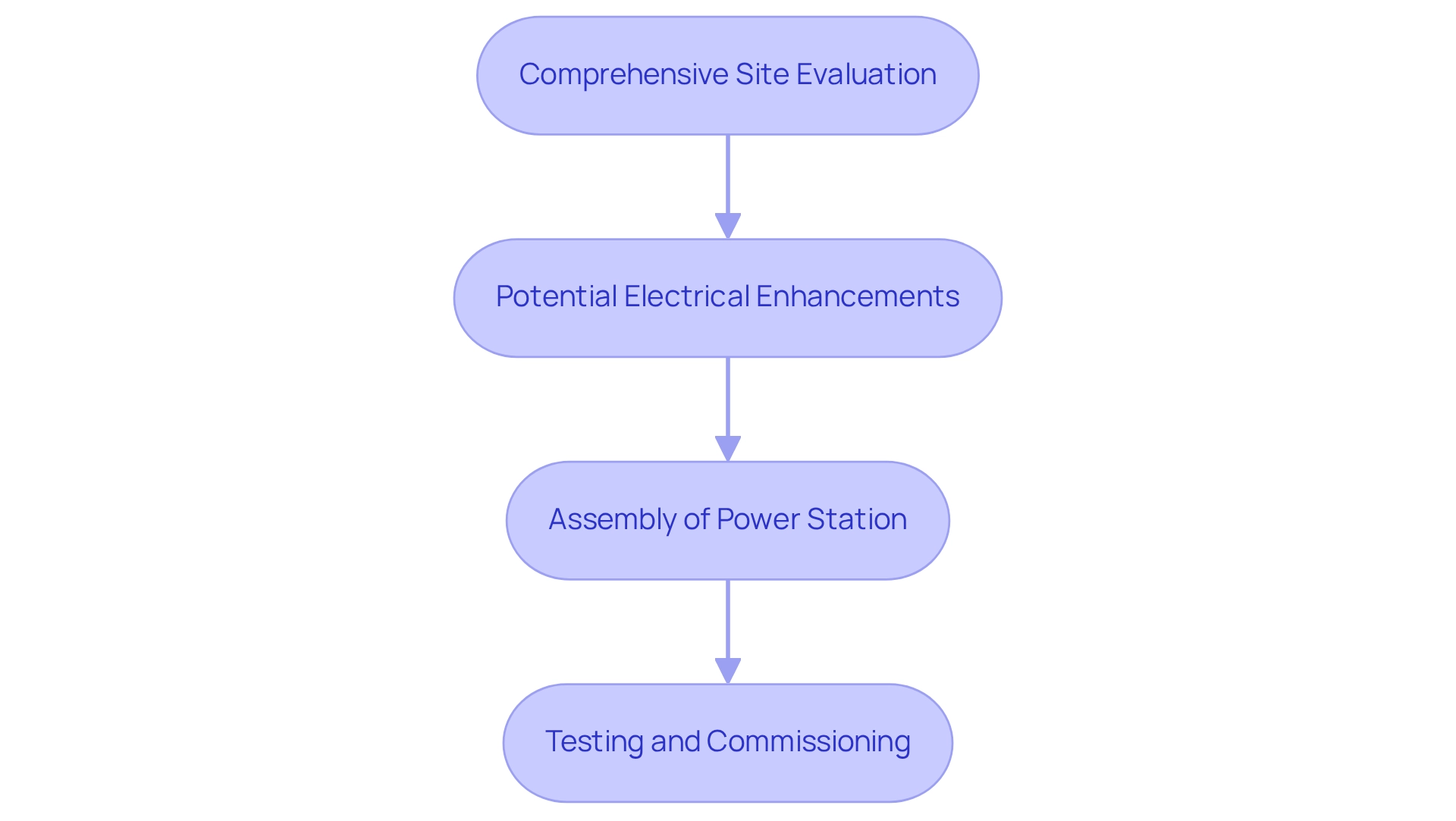Overview
We understand that choosing the best place to install a Tesla charger in your garage can feel overwhelming. It’s essential to find a location that maximizes accessibility, minimizes setup costs, and ensures safety. Ideally, this spot should be near your electrical panel and free from obstructions.
By strategically placing your charger, you not only enhance user convenience but also reduce installation expenses and prevent potential hazards. Together, these factors lead to a more efficient and worry-free charging experience.
Remember, we’re here to support you in making informed decisions that align with your energy independence goals.
Introduction
In the rapidly evolving landscape of electric vehicles, we understand that the importance of thoughtful Tesla charger installation cannot be overstated. As more homeowners embrace sustainable transportation, it’s common to feel overwhelmed by the nuances of charger placement, electrical requirements, and local regulations. However, understanding these elements is crucial for a seamless charging experience.
From optimizing garage layouts to integrating solar energy solutions, every detail contributes not just to convenience but also to safety and efficiency. As the demand for electric vehicles continues to surge, so too does the need for reliable and accessible charging infrastructure.
Together, we can explore the essential considerations for Tesla charger installation, empowering you to make informed decisions that enhance your electric vehicle ownership experience.
Understanding the Importance of Charger Placement
Choosing the best place to install a Tesla charger in your garage is essential for several compelling reasons. We understand that the ease of connecting your vehicle is a top concern. A strategically located charger can significantly reduce the need for awkward maneuvers in tight spaces, making the charging process smoother and more efficient.
Moreover, the position of the charger can have a substantial impact on setup costs. For instance, placing it near the electrical panel can lead to lower wiring expenses and quicker installation times, ultimately saving you money. This consideration becomes increasingly relevant as the demand for electric vehicles (EVs) grows, with EVs representing over 10% of new car sales in states like California.
Safety is another vital aspect to think about when determining where to place your charger. A well-positioned power supply ensures that cables do not obstruct walkways or create tripping hazards, contributing to a safer garage environment. This is particularly important in homes with multiple occupants or pets.
In addition to these practical considerations, understanding how solar panels work can enhance your overall energy efficiency. By incorporating solar energy solutions, you can reduce your dependence on the grid and improve your energy usage, especially when powering your EVs. Selecting the optimal solar batteries for effective energy storage further enhances this setup, ensuring you have a reliable power source for your Tesla.
Recent research highlights that the best place to install a Tesla charger in your garage is crucial for improving the overall charging experience. Case studies show that thoughtful placement can enhance accessibility and user satisfaction. As Greg Sowder, President of Qmerit Network, points out, “An EV Charging Maintenance Guide for Commercial Building Owners” emphasizes the importance of proper placement for maximizing efficiency and safety.
As the electric vehicle landscape continues to evolve, innovative solutions like electric road systems (ERS) are being explored worldwide, allowing vehicles to charge while driving. This trend underscores the need to adapt to new technologies and practices in electric vehicle power supply. Additionally, the increase in publicly available charging stations in Europe, which rose by 30% in 2021, reflects the expanding infrastructure supporting electric vehicles and may resonate with environmentally conscious homeowners considering their own charging solutions.
In summary, carefully evaluating the best place to install a Tesla charger in your garage not only facilitates a smooth charging experience but also influences setup costs and safety. By integrating solar energy solutions and selecting the right battery storage, you can create a sustainable and efficient charging environment for your electric vehicle. Together, we can ensure that your Tesla charging device is optimally positioned and seamlessly integrated with solar energy solutions. Powercore Electric is here to support you every step of the way.
Key Electrical Requirements for Tesla Charger Installation
Installing a Tesla charging station is an important step towards energy independence, and it requires careful attention to specific electrical requirements to ensure both safety and efficiency. We understand that homeowners are often concerned about energy bills, and the Tesla Wall Connector typically demands a dedicated 240-volt circuit. It’s essential to verify that your electrical panel can accommodate this additional load, usually requiring a 60-amp breaker for optimal performance.
Moreover, selecting the appropriate gauge wiring is critical; 6 AWG wire is often recommended for high-capacity installations to safely handle the increased current. Compliance with local electrical codes and regulations is paramount, as these standards are established to promote safety and reliability in electrical installations. As we look towards 2025, updates to Tesla charging electrical standards emphasize the need for robust infrastructure to support the growing demand for electric vehicles (EVs). With the global lithium-ion automotive battery production capacity expected to rise to 3.2 TWh by 2030, the significance of effective power solutions becomes even more pronounced.
Significantly, DC fast power supply can offer an estimated electric range of 180-240 miles per hour, underscoring the need for efficient power arrangements.
Successful case studies showcase residences that have thoughtfully determined the best place to install a Tesla charger in the garage and seamlessly incorporated them into their electrical systems. For instance, a recent setup in a Roseville residence included a thorough evaluation of the current electrical panel, followed by the addition of a dedicated circuit and suitable wiring. This meticulous planning not only ensured compliance with electrical standards but also identified the optimal location for the Tesla charger, allowing the property owner to enjoy the convenience of charging their Tesla efficiently.
These installations not only boost energy autonomy but also contribute to long-term reductions in energy expenses, aligning with the objectives of environmentally conscious individuals. Additionally, by considering the economic advantages of solar battery systems, such as lowered energy costs and possible tax incentives, property owners can further enhance their investments in renewable energy solutions. Government programs also provide valuable incentives for those looking to adopt solar energy systems, making it easier to embrace these technologies.
By ensuring that all electrical requirements are fulfilled, homeowners can enjoy the convenience of EV power supply while safeguarding their homes against potential electrical issues. If you’re considering a Tesla charger setup or exploring solar battery options, we invite you to reach out to Powercore Electric today! Together, we can work towards a more sustainable future.
Exploring Different Types of Tesla Chargers
At Tesla, we understand that navigating power solutions can feel overwhelming, especially when considering the impact on your energy bills. That’s why we offer a range of customized solutions designed to meet your unique needs. Among these, the Tesla Wall Connector stands out as a hardwired option that delivers impressive power, providing up to 44 miles of range per hour. This makes it an excellent choice for daily use, allowing you to recharge your electric vehicle (EV) overnight or during the day with ease.
On the other hand, the Mobile Connector offers a versatile, portable solution that plugs into standard outlets, giving you the freedom to charge on the go. While it operates at reduced speeds, its convenience is invaluable for those who travel frequently. We recognize that understanding the differences between these options is crucial for homeowners. This knowledge empowers you to determine the best place to install a Tesla charger in your garage based on your energy habits and vehicle usage.
Looking ahead, it’s exciting to note that by 2030, the global lithium-ion automotive battery manufacturing capacity is projected to soar to 3.2 TWh, a remarkable increase from 300 GWh in 2021. This growth underscores the rising demand for EVs and the importance of effective home power solutions. As you evaluate your options, consider how local service providers like Powercore Electric can assist with installation and maintenance, ensuring your Tesla charger performs optimally in your garage.
Moreover, Tesla owners can easily manage their home power supply through the Tesla app, which features usage statistics and remote diagnostics. This enhances your experience and adds a layer of convenience that we hope you’ll appreciate.
Real-world experiences highlight the effectiveness of both the Wall Connector and Mobile Connector. For instance, residents who have installed the Wall Connector report significantly shorter charging times, allowing them to maximize their vehicle’s range with minimal downtime. Meanwhile, those using the Mobile Connector value its flexibility during travel, enabling them to charge their vehicles at various locations without needing dedicated infrastructure.
Powercore Electric stands out by fostering a strong community focus and a commitment to transparency, offering personalized service to clients throughout California. With expertise in solar panels, battery backups, and electric vehicle power sources, they are well-equipped to guide you in selecting and installing the right power solution for your needs. This regional knowledge is invaluable for homeowners seeking EV power solutions, ensuring you receive high-quality service tailored to your requirements.
If you have questions or need assistance, feel free to reach out to Powercore Electric at ryan.serrano@powercoreinc.net or call (916) 699-8778. Ultimately, the decision regarding the best place to install a Tesla charger in your garage depends on your individual lifestyle and charging needs. It’s essential to thoughtfully evaluate your options.
Additionally, Powercore Electric’s offerings, including solar panels and battery backups, provide comprehensive solutions that can enhance the efficiency of your home energy use, setting them apart from competitors. Together, we can work towards a sustainable future that meets your energy needs.
Assessing Your Garage Layout and Space Constraints
When considering the best location to install a Tesla charger in your garage, we understand that evaluating your garage layout is essential. Key factors to keep in mind include:
- The dimensions of your garage
- The positioning of your vehicle
- The proximity to your electrical panel
For instance, in a standard two-car garage, placing the Tesla charger centrally allows for easy access, regardless of how you park, enhancing your convenience.
Moreover, ensuring sufficient space around the charger is crucial for safe operation and to prevent any blockages.
It’s important to recognize that garage dimensions in California homes can vary significantly, and many residents face space limitations that may impact charger placement. Notably, 56% of participants reported that buyers’ expectations regarding the number of properties viewed before purchasing aligned with the market, highlighting that garage design factors are increasingly important for eco-conscious property owners looking to invest in sustainable solutions. As we look ahead to 2025, trends in garage space optimization will emphasize the importance of efficient designs that accommodate electric vehicle power sources without compromising functionality.
For example, opting for wall-mounted chargers can save floor space while enhancing accessibility. Additionally, as homeowners explore the possibility of incorporating solar energy, understanding the relationship between solar batteries and EV chargers becomes essential. Choosing the right solar battery involves evaluating factors such as capacity, lifespan, efficiency, and cost, which can significantly enhance the performance of your energy setup, ensuring that you maximize your investment in sustainable energy.
Case studies reveal that residents who carefully assess the best location for a Tesla charger in their garage before installation often enjoy a smoother power experience and greater satisfaction with their setup. At Powercore Electric, our strong community focus and commitment to personalized service ensure that our team is here to assist homeowners in finding the ideal spot for their Tesla charger. By taking the time to consider these spatial constraints and the benefits of solar energy, together we can achieve a more efficient installation and an improved overall energy experience.
Ensuring Accessibility and Convenience in Charger Placement
Accessibility plays a vital role in determining the ideal spot for installing a Tesla charger in your garage, particularly when integrating solar power solutions. We understand that ensuring your power supply is positioned conveniently is essential for easy access to your vehicle’s power inlet. This prevents excessive stretching of the cable, which can lead to wear and tear over time. Additionally, it’s important to consider the flow of traffic in your garage; the best place for a Tesla charger is one that doesn’t obstruct pathways or create potential hazards.
For those with multiple vehicles, the optimal location for a Tesla charger can significantly enhance convenience, allowing every user to enjoy easy access. This strategic placement not only facilitates regular charging but also encourages the use of electric vehicles by making the charging process seamless and user-friendly.
Incorporating solar energy into your charging setup can further elevate your experience. By utilizing solar panels, you can generate your own electricity, reducing reliance on the grid and lowering your energy costs. It’s noteworthy that recent studies indicate 64% of Americans live within two miles of a public power station, suggesting that proximity to power infrastructure positively influences perceptions of electric vehicles.
This trend underscores the importance of accessibility in positioning your power source at home. Convenient setups can lead to more frequent usage and greater overall satisfaction with electric vehicle ownership. Moreover, the anticipated rise in DC fast power sources, supported by federal initiatives, emphasizes the need for homeowners to thoughtfully consider their future power options when planning their setups. In 2025, determining the best place to install a Tesla charger in your garage will involve ensuring the area is well-lit and free of obstacles, along with evaluating your garage’s design to maximize space.
Powercore Electric offers a comprehensive installation procedure for EV supply stations, which includes site evaluation, electrical enhancements, installation, and testing. Utilizing tools like the Station Locator, which confirms current power supply locations each year, can help you stay informed about nearby energy options. By prioritizing accessibility and integrating solar power solutions, you can maximize the benefits of your electric vehicle, making charging a hassle-free part of your daily routine.
Research findings reveal that city dwellers, often younger and more educated, are more likely to live near charging stations. This emphasizes the importance of strategic positioning in enhancing user convenience. Together, we can work towards creating a more sustainable future, ensuring that your charging experience is not only efficient but also enriching.
Navigating Local Regulations and Permits for Installation
Before moving forward with the setup of a Tesla charging station, we understand that it’s crucial to grasp the local regulations and permitting requirements that may be relevant. In many regions, obtaining a permit for electrical setups, including EV chargers, is necessary. We encourage homeowners to consult their local building department to ascertain the specific requirements in their area.
This process often entails submitting detailed plans for the installation, ensuring adherence to electrical codes, and scheduling required inspections. It’s common to feel overwhelmed by these regulations at first, but remember, this is a vital step to ensure a safe and compliant installation that meets all relevant standards. For instance, recent data indicates that the stock of home chargers is projected to grow more than tenfold by 2035, reaching over 270 million units. This surge underscores the importance of establishing clear guidelines and efficient permitting processes to support the growing demand for EV infrastructure.
In California, where the number of EV refueling stations has seen a significant rise—7.7% overall in Q3 2023, with public ports increasing by 8.4%—local regulations are adapting to facilitate this expansion. As Omar Vargas, head of public policy at General Motors, mentioned, “We’re assisting with that type of planning, and we’re quite certain that in the next few years, we’re going to have a robust EV refueling network in the United States.” This highlights the importance of planning for a strong EV infrastructure, aligning with the conversation on local regulations and permitting.
Moreover, the setup procedure for EV power stations by Powercore Electric includes several essential stages:
- A comprehensive site evaluation to identify the best place to install a Tesla charger in the garage and assess electrical needs.
- Potential electrical enhancements to support the installation.
- The actual assembly of the power station ensuring adherence to safety and regulatory standards.
- Thorough testing and commissioning to guarantee optimal performance before transfer.
Understanding these regulations not only aids in a smoother setup process but also supports the larger objective of improving the EV charging network, as emphasized by current research and development initiatives focused on closing technology gaps in EV charging.
By staying informed about local permitting criteria and actively engaging with your community’s regulations, you can ensure that your Tesla power setup is both efficient and compliant, paving the way for a sustainable energy future. It’s also beneficial to acknowledge that the typical duration to acquire permits for EV charging setups can vary, so being proactive in your application can help expedite the process. Additionally, examining instances of successful permit requests for Tesla charging setups can offer valuable insights and guidance for homeowners embarking on this journey.
Planning for Future Upgrades and Technological Changes
As electric vehicle (EV) technology swiftly progresses, we understand that preparing for future enhancements during the installation of your Tesla power supply is crucial. Homeowners should contemplate their long-term requirements, such as the potential of obtaining a second EV or upgrading to a higher-capacity power source. Ensuring that your electrical system can support these changes is vital for seamless integration.
When selecting the best place to install a Tesla charger in the garage, consider a spot that allows for convenient access to extra power sources later on. This foresight can prevent costly modifications in the future and maintain the efficiency of your power setup for years to come.
The average lifespan of electric vehicle charging stations is usually about 10 to 15 years, but improvements in technology might require upgrades sooner. Staying informed about emerging technologies and trends in EV charging can assist residents in making educated decisions. For instance, the automotive industry is witnessing a significant shift towards electrification, with major manufacturers committing to expanding their electric vehicle lineups.
This trend is supported by substantial investments in research and development, making electric vehicles more accessible and appealing to consumers. Significantly, Tesla has lowered the cost of its Model Y, making it more accessible for a wider public, which may affect the choices of property owners regarding the installation of charging stations.
Along with EV power sources, incorporating solar energy solutions can enhance the overall efficiency of your home’s energy system. By utilizing solar panels, homeowners can produce their own electricity, which can be used to energize their electric vehicle stations, further decreasing energy expenses and dependence on the grid. Powercore Electric provides extensive installation services for both Tesla charging stations and solar energy systems, ensuring that your home is prepared for the future.
Expert opinions suggest that planning for future upgrades is not just a matter of convenience but also a strategic investment. As electric car sales surged by approximately 25% in the first quarter of 2024 compared to the previous year, the demand for efficient charging solutions is expected to grow. Homeowners should also consider the implications of multiple EVs in their households, as this will affect the quantity of charging stations required and their placement.
Government initiatives, including the Inflation Reduction Act, are further promoting electric car adoption through various incentives and tax credits, creating a supportive environment for residents to invest in EV chargers and solar energy solutions.
As the President of Qmerit Network stated, “We’re here to make your electrification journey easy and provide a first-class experience with the highest quality of materials and service.” By proactively addressing these considerations, homeowners can determine the best place to install a Tesla charger in the garage, ensuring their EV charging infrastructure is robust and adaptable to meet the evolving demands of electric vehicle ownership.
Conclusion
Thoughtful installation of Tesla chargers is essential for enhancing your electric vehicle ownership experience. We understand that concerns about energy bills are prevalent, and key considerations such as charger placement, electrical requirements, and local regulations play a significant role in ensuring your convenience, safety, and efficiency. Selecting the optimal location that minimizes installation costs, along with understanding specific electrical needs like dedicated circuits and wiring, contributes to a seamless charging experience.
Moreover, integrating solar energy solutions can significantly boost your energy efficiency, allowing you to reduce reliance on traditional power sources. With the rising demand for electric vehicles and advancements in charging technology, it’s important to stay informed about various charger types and their respective benefits. The choice between Tesla’s Wall Connector and Mobile Connector, along with planning for future upgrades, underscores the importance of aligning your installation decisions with long-term needs.
Navigating local regulations and ensuring proper installation processes are crucial steps that foster a compliant and effective EV charging setup. By prioritizing these considerations, you can create a sustainable and efficient charging environment that enhances your electric vehicle experience. As the electric vehicle landscape continues to evolve, proactive planning and expert assistance can pave the way for a future-ready charging infrastructure, making electric vehicle ownership not only practical but also rewarding. Together, let’s work towards creating a charging solution that meets your needs and supports your journey towards energy independence.






